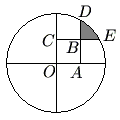Difference between revisions of "2006 AMC 10B Problems/Problem 19"
m (added category) |
(→Solution) |
||
| Line 8: | Line 8: | ||
== Solution == | == Solution == | ||
| − | The shaded area is | + | The shaded area is equivalent to the area of sector <math>DOE</math>, minus the area of triangle <math>DOE</math> plus the area of triangle <math>DBE</math>. |
Using the Pythagorean Theorem: | Using the Pythagorean Theorem: | ||
Revision as of 16:31, 11 May 2008
Problem
A circle of radius ![]() is centered at
is centered at ![]() . Square
. Square ![]() has side length
has side length ![]() . Sides
. Sides ![]() and
and ![]() are extended past
are extended past ![]() to meet the circle at
to meet the circle at ![]() and
and ![]() , respectively. What is the area of the shaded region in the figure, which is bounded by
, respectively. What is the area of the shaded region in the figure, which is bounded by ![]() ,
, ![]() , and the minor arc connecting
, and the minor arc connecting ![]() and
and ![]() ?
?
![]()
Solution
The shaded area is equivalent to the area of sector ![]() , minus the area of triangle
, minus the area of triangle ![]() plus the area of triangle
plus the area of triangle ![]() .
.
Using the Pythagorean Theorem:
![]()
![]()
Clearly, ![]() and
and ![]() are
are ![]() triangles with
triangles with ![]() .
.
Since ![]() is a square,
is a square, ![]() .
.
![]() can be found by doing some subtraction of angles.
can be found by doing some subtraction of angles.
![]()
![]()
![]()
![]()
So, the area of sector ![]() is
is ![]() .
.
The area of triangle ![]() is
is ![]() .
.
Since ![]() ,
, ![]() .
.
So, the area of triangle ![]() is
is ![]() .
.
Therefore, the shaded area is ![]()










